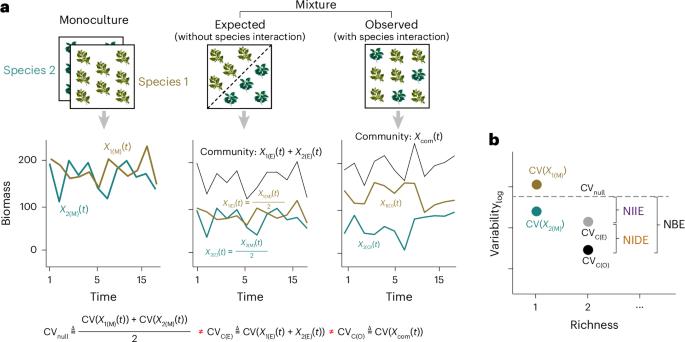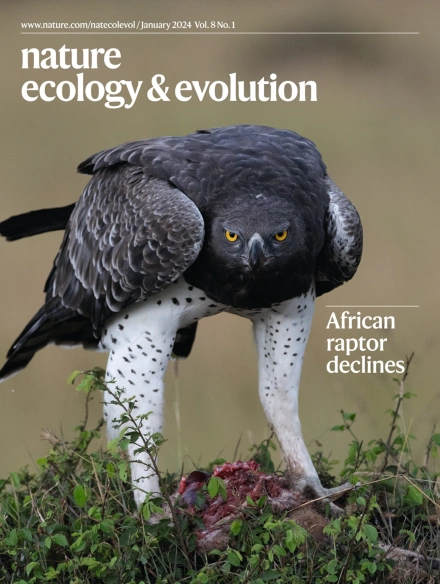草原生物多样性的稳定效应来自于物种特有的动态,而不是种间的相互作用
IF 13.9
1区 生物学
Q1 ECOLOGY
引用次数: 0
摘要
尽管许多研究已经证明了生物多样性与生态系统稳定性之间的正相关关系,即生态系统功能的低时间变异性,但种间相互作用在推动这种关系中的作用仍然难以捉摸。在这里,我们开发了一个划分框架,将种间相互作用对生态系统变异性的影响与相互作用独立过程的影响分开。将这一框架应用于欧洲和北美草原的竞争模型和生物多样性实验,我们发现,在单一栽培中可观察到的物种特异性动态(例如,环境响应或人口统计学随机性),而不是仅在混合栽培中可观察到的种间相互作用,解释了生物多样性对生态系统的稳定作用。种间相互作用的弱净效应来自两种平衡效应:相互作用驱动的平均物种变异性增加和相互作用驱动的平均物种同步性减少。我们还发现,有助于提高生态系统功能的种间相互作用往往会降低生态系统的变异性。我们的研究对种间相互作用在塑造草原生态系统稳定性中的作用进行了系统的实证评估,挑战了关于其重要性的传统假设,并强调了物种特异性动态是普遍存在的生物多样性-稳定性关系的主要机制。本文章由计算机程序翻译,如有差异,请以英文原文为准。


Stabilizing effects of biodiversity arise from species-specific dynamics rather than interspecific interactions in grasslands
Although numerous studies have demonstrated a positive relationship between biodiversity and ecosystem stability, that is low temporal variability in ecosystem functions, the role of interspecific interactions in driving this relationship remains elusive. Here we develop a partitioning framework to disentangle the effects of interspecific interactions on ecosystem variability from those of interaction-independent processes. Applying this framework to competition models and biodiversity experiments in European and North American grasslands, we find that species-specific dynamics observable in monocultures (for example, environmental responses or demographic stochasticity), rather than interspecific interactions observable only in mixtures, explain much of the stabilizing effects of biodiversity on ecosystems. The weak net effect of interspecific interactions results from two counter-balancing effects: an interaction-driven increase in average species variability and an interaction-driven decrease in average species synchrony. We also find that interspecific interactions contributing to higher ecosystem functioning tend to reduce ecosystem variability. Our study provides a systematic empirical assessment of the role of interspecific interactions in shaping grassland ecosystem stability, challenging traditional assumptions about their importance and highlighting species-specific dynamics as the primary mechanism underlying the pervasive biodiversity–stability relationship. The role of interspecific interactions in biodiversity–ecosystem stability relationships is unclear. Here the authors develop a theoretical approach and show that empirical diversity–stability relationships in grasslands are best explained by species-specific dynamics rather than by interspecific interactions.
求助全文
通过发布文献求助,成功后即可免费获取论文全文。
去求助
来源期刊

Nature ecology & evolution
Agricultural and Biological Sciences-Ecology, Evolution, Behavior and Systematics
CiteScore
22.20
自引率
2.40%
发文量
282
期刊介绍:
Nature Ecology & Evolution is interested in the full spectrum of ecological and evolutionary biology, encompassing approaches at the molecular, organismal, population, community and ecosystem levels, as well as relevant parts of the social sciences. Nature Ecology & Evolution provides a place where all researchers and policymakers interested in all aspects of life's diversity can come together to learn about the most accomplished and significant advances in the field and to discuss topical issues. An online-only monthly journal, our broad scope ensures that the research published reaches the widest possible audience of scientists.
 求助内容:
求助内容: 应助结果提醒方式:
应助结果提醒方式:


